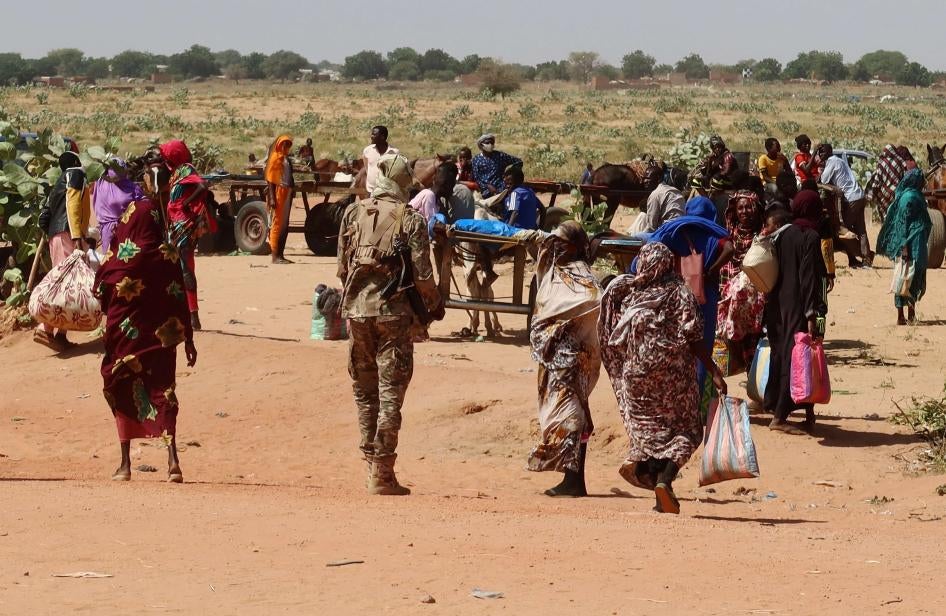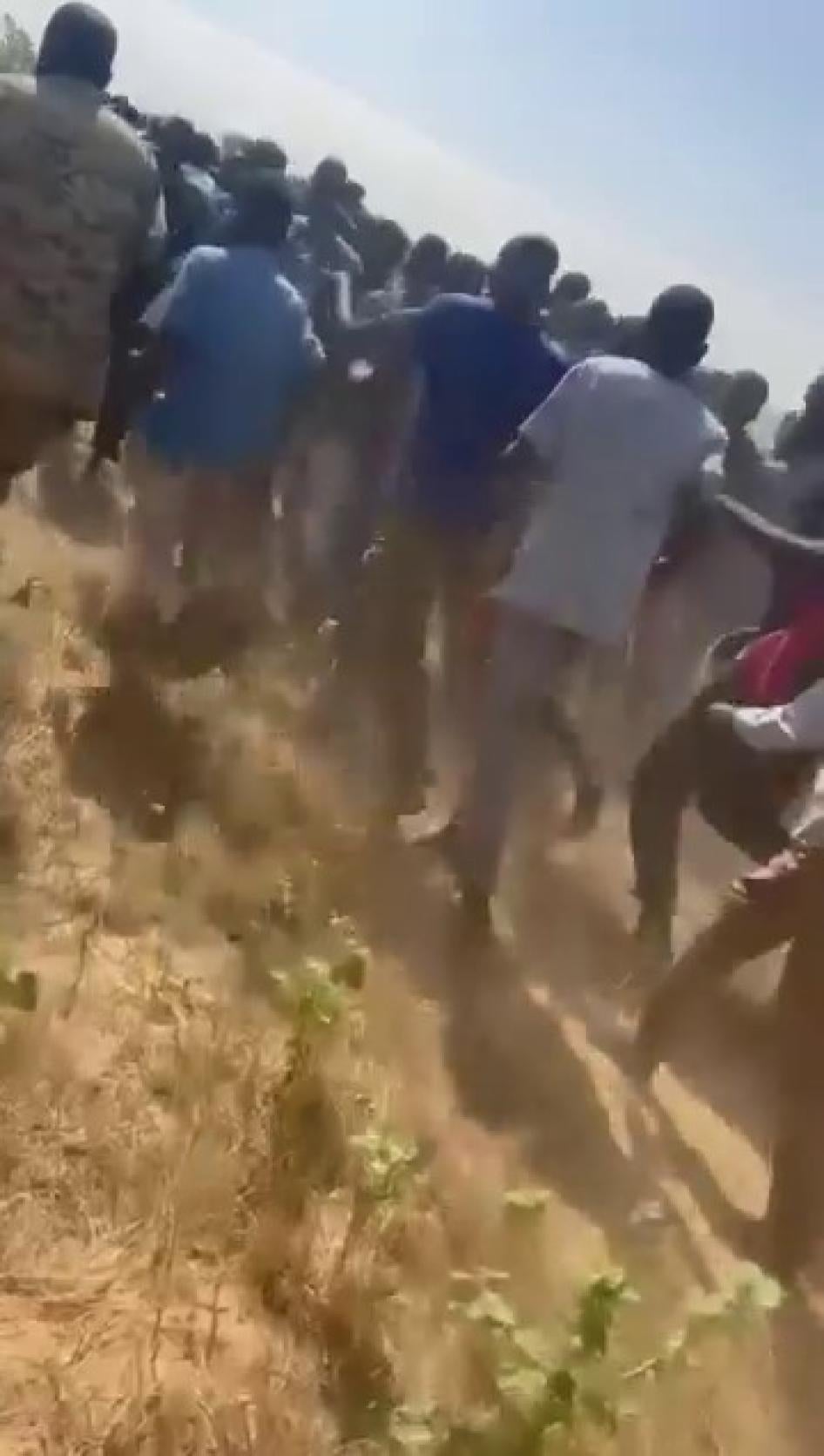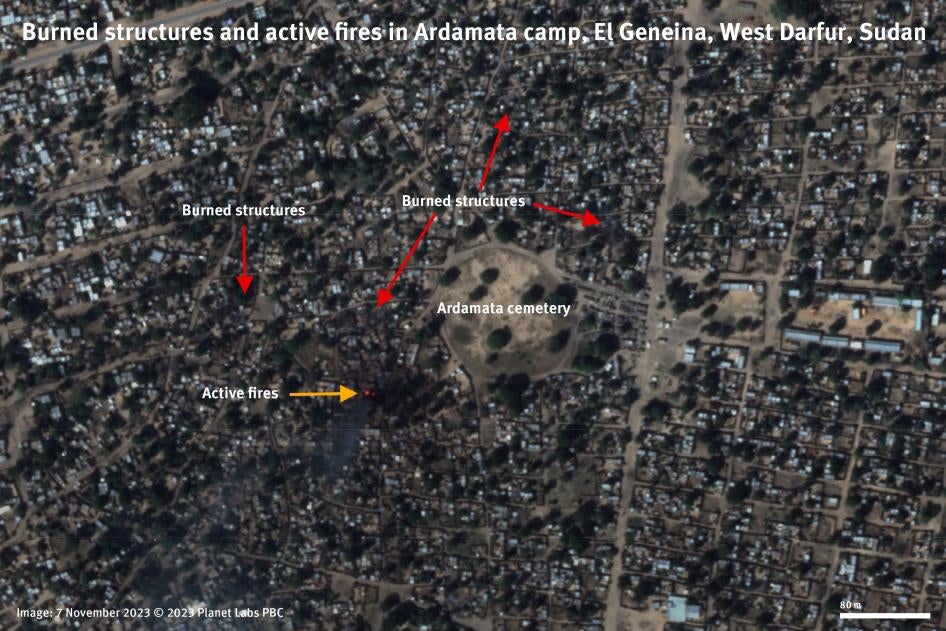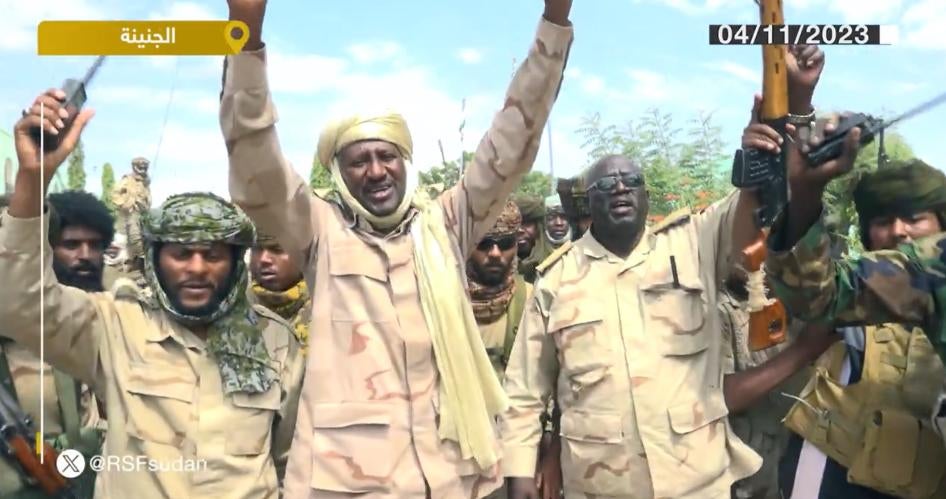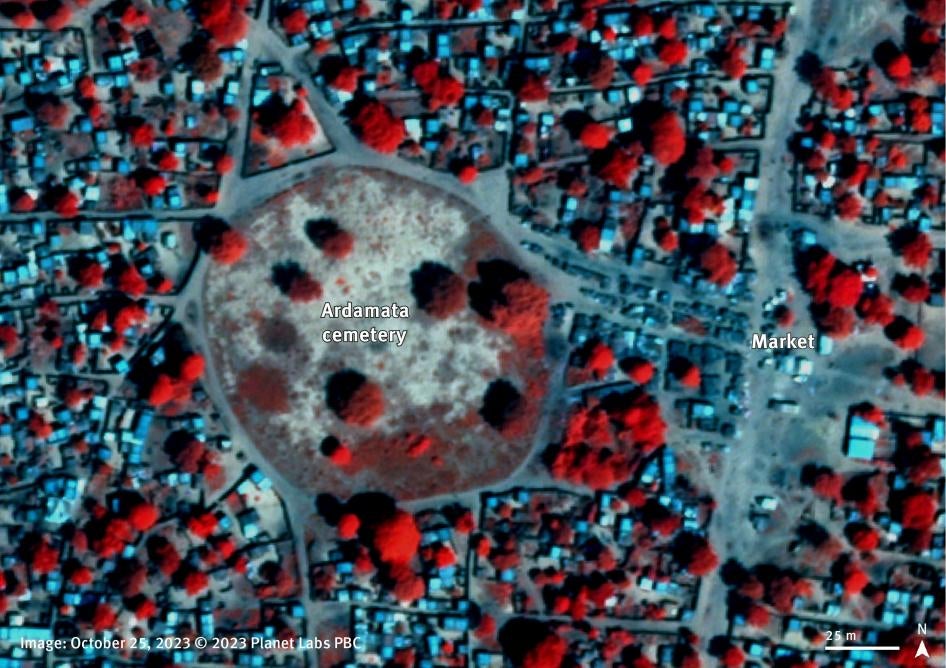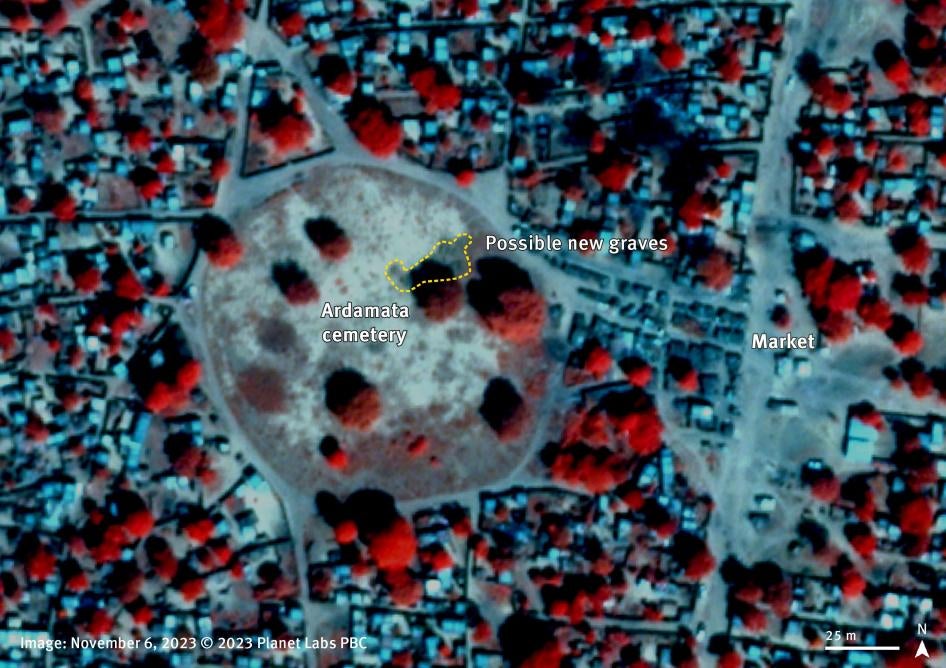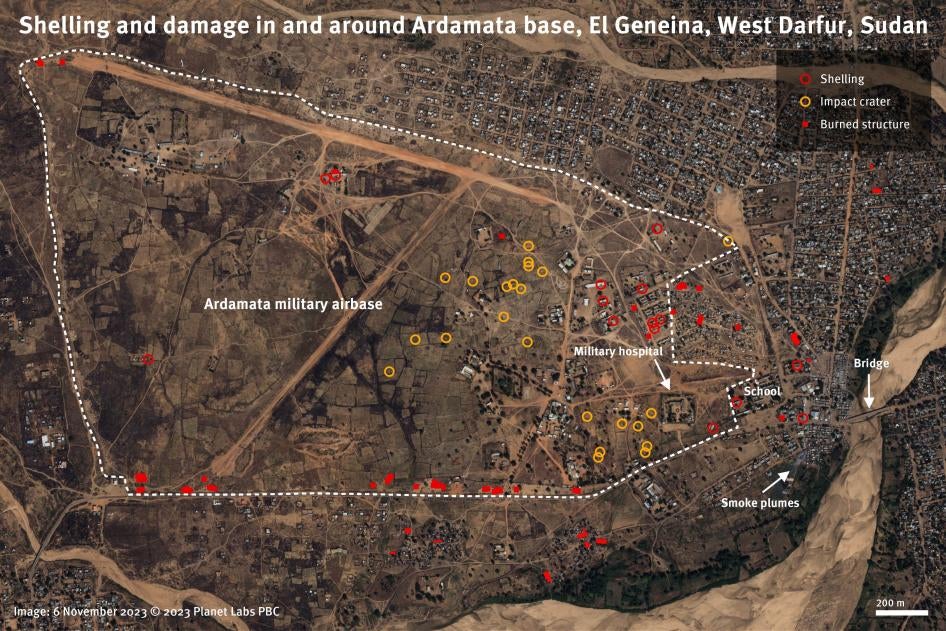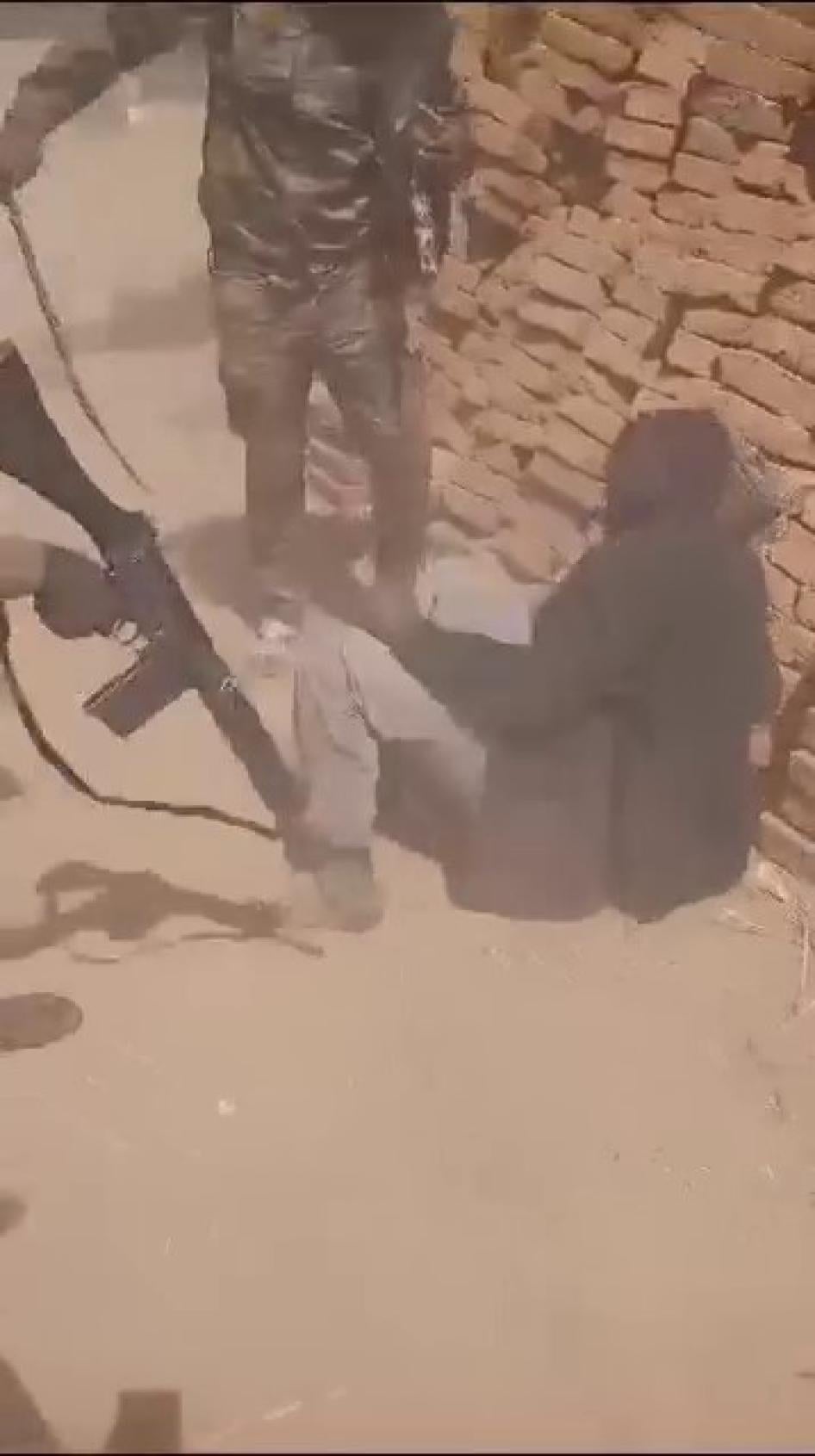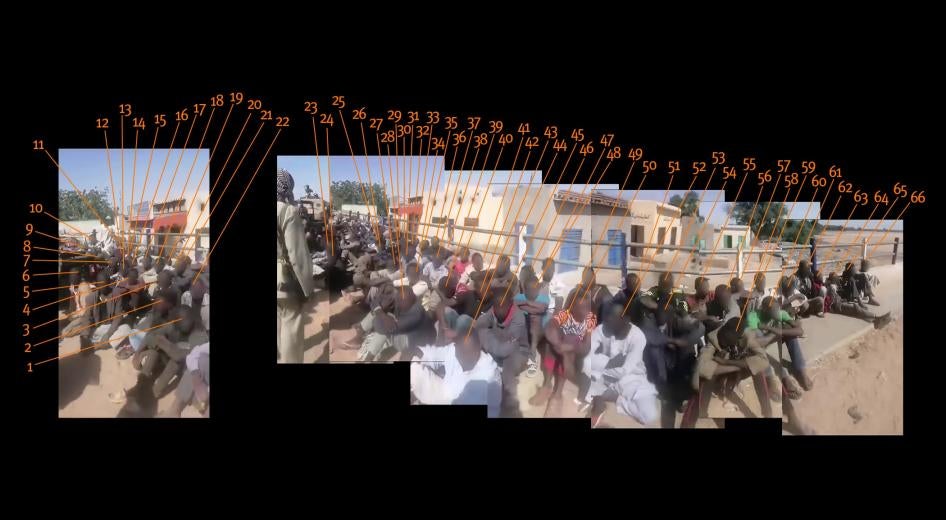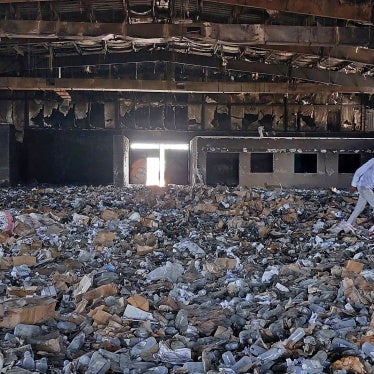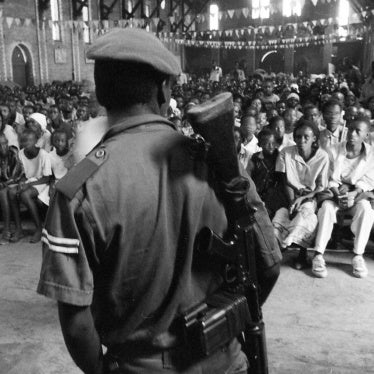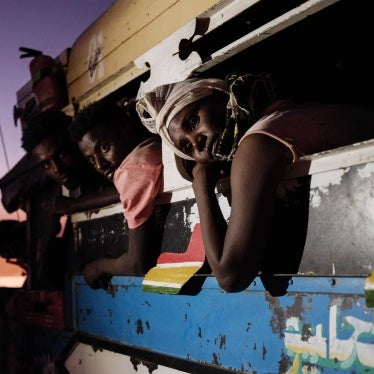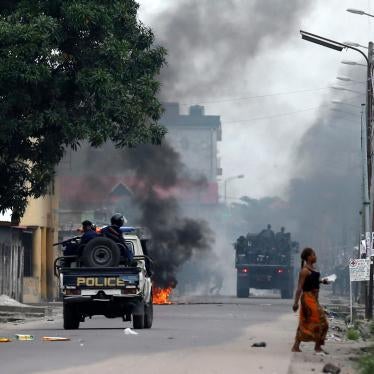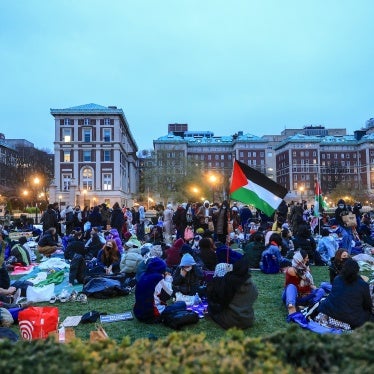- The Rapid Support Forces killed hundreds of civilians in West Darfur in early November 2023.
- The Rapid Support Forces’ latest episode of ethnically targeted killings in West Darfur, has the hallmarks of an organized campaign of atrocities against Massalit civilians.
- The United Nations Security Council should urgently strengthen the UN’s presence in Sudan to prevent further atrocities and better protect civilians in Darfur.
(Nairobi) – The Rapid Support Forces and their allied militias killed hundreds of civilians in West Darfur in early November 2023, Human Rights Watch said today. The forces also looted, assaulted, and unlawfully detained scores of members of the predominantly Massalit community in Ardamata, a suburb of West Darfur’s El Geneina.
Given the pending closure of the UN mission in Sudan, and replacement by a special envoy, the United Nations Security Council should urgently consider ways to strengthen the UN’s presence in Sudan that could deter further atrocities and better protect civilians in Darfur. It should support monitoring of human rights abuses there and expand the existing arms embargo to cover the entire country and all parties to the ongoing armed conflict. African members of the Security Council, the United Arab Emirates, and other governments on the council should support these and other measures to ensure the UN’s most powerful body is able to fulfill its responsibility to protect civilians in West Darfur and the rest of Sudan.
“The Rapid Support Forces’ latest episode of ethnically targeted killings in West Darfur, has the hallmarks of an organized campaign of atrocities against Massalit civilians,” said Mohamed Osman, Sudan researcher at Human Rights Watch. “The UN Security Council needs to stop ignoring the desperate need to protect Darfur civilians.”
According to the UN Refugee Agency (UNHCR), an estimated 800 people were killed during the early November attacks in Ardamata. Local rights monitors interviewed survivors arriving in Chad and estimated the death toll of mainly civilians at between 1,300 and 2,000, including dozens killed on the road to Chad. At least 8,000 people have fled into Chad, joining around 450,000, mostly women and children, displaced by attacks in West Darfur notably between April and June.
Human Rights Watch interviewed 20 Massalit people who fled Ardamata to eastern Chad between November 1-10, including 3 Sudanese Armed Forces (SAF) soldiers, who described a spree of killings, shelling, unlawful detentions, sexual violence, ill-treatment, and looting. All interviewees are identified by pseudonyms for their protection. Human Rights Watch also analyzed 8 videos and images posted on social media that show the Rapid Support Forces detaining over 200 men and boys in Ardamata. One video shows the fighters beating a group of men.
Human Rights Watch shared a letter with the Rapid Support Forces, sharing findings and questions, but received no response before the date of publishing.
Satellite imagery taken the first week of November shows the impact of the shelling on civilian and military infrastructure as well as looting and arson in and around the Ardamata displaced people’s camp. Satellite imagery also shows possible new graves and bodies in the street.
Conflict broke out on April 15 in Sudan between the country’s two military forces, the Sudanese Armed Forces and the Rapid Support Forces. Between April and June, the Rapid Support Forces and allied militia led waves of assaults against majority-Massalit neighborhoods of El Geneina, as well as other towns and villages in the region, targeting civilians on a large scale.
Ongoing Human Rights Watch research and media reports indicate that they killed civilians by the thousands, burned whole neighborhoods and sites where displaced people had found refuge in El Geneina, looted on a grand scale, and raped women and girls. These attacks forcibly displaced hundreds of thousands of civilians, with thousands seeking refuge in Ardamata. Ardamata hosts both a Sudanese Armed Forces base and an internally displaced people’s camp.
Survivors and local monitors said that on November 1, fighting broke out again between the Rapid Support Forces and the Sudanese Armed Forces. During the two days of heavy fighting that followed, both parties shelled the suburb, in some cases affecting civilians. Residents said that some Massalit fighters joined the fight alongside the Sudanese Armed Forces. From November 4, after the Rapid Support Forces and militia gained control of the Sudanese Armed Forces base, they went on a rampage through the camp for displaced people, and other residential areas, all largely inhabited by Massalit and other non-Arab groups.
Survivors said that the Rapid Support Forces and allied forces shot at civilians as they fled and executed people in their homes, shelters, and in the streets. Survivors said attackers insulted the Massalit, and in some instances said they wanted to “kill Massalit.” The assailants killed primarily Massalit men, but two people interviewed said that people from non-Arab groups, notably ethnic Tama and Eringa, were also killed and injured.
On November 7, a 45-year-old Massalit farmer said, Arab militiamen accompanied by Rapid Support Forces vehicles entered the house where he was sheltering in Ardamata camp. The attackers brought seven men to the front of the house:
“They [the assailants] told me to come out of the house,” the man said. “The moment I came out, one or two of the Arabs shot at the seven men from close range. They immediately executed them. All of them lay there on the ground. One of the [assailants] said to me: ‘See how many we killed?’ They told me then to leave the town.”
As in the waves of violence in El Geneina just five months ago, the Rapid Support Forces and their allies targeted prominent Massalit community members. Among them was Mohamed Arbab, 85, a tribal leader from Misterei town who was reportedly killed alongside his son and seven grandchildren on November 4.
Videos and images posted on social media in early November, verified and analyzed by Human Rights Watch show Rapid Support Forces and Arab militiamen detaining more than 200 men and boys in 3 locations in Ardamata.
A series of 5 videos uploaded to Telegram and Facebook between November 4 and 5 also show a group of at least 125 men and boys being forced to run toward El Geneina airport, east of Ardamata. Several of the men are visibly wounded, including some who are limping, while one person is seen being carried by four other men. Human Rights Watch was not able to determine what happened to any members of these groups.
The attackers looted houses and robbed people as they fled, beating, and otherwise ill-treating them. Signs of looting and arson damage are visible in satellite imagery taken of Ardamata camp from November 5 to 7, with fire visible around the camp’s cemetery.
Videos dated November 4 from the Rapid Support Forces’ official X (formerly known as Twitter) account and geolocated by Human Rights Watch show Abdel Raheem Hamdan Dagalo, the Rapid Support Forces deputy commander and brother of Rapid Support Forces leader Mohamed Hamdan Dagalo “Hemedti,” in Ardamata celebrating with his forces the takeover of the Sudanese Armed Forces base, alongside General Abdel Rahman Joma’a, the Rapid Support Forces’ West Darfur Commander. Following the takeover of the base, Abdel Raheem announced that Joma’a was appointed commander of the 15th military division.
Under international law, deliberate attacks on the civilian population, including extrajudicial killings, mistreatment of civilians and all those not participating in combat such as detainees and the wounded; and forcible displacement, violate the laws of war, and may be prosecuted as war crimes. Acts of murder, rape, torture, deportations, persecution, and other offenses committed as part of a widespread or systematic attack against a civilian population based on a government or organizational policy constitute crimes against humanity.
On November 16, Sudan asked the UN to end the mandate of its country’s political mission. The next day, the UN Secretary-General appointed a personal envoy on Sudan, which would significantly reduce UN scrutiny over the situation. UN Security Council and other critical stakeholders should be considering all options to prevent further atrocities and protect civilian populations. As a first step, UN Security Council members should organize a council visit to eastern Chad to meet with survivors of current atrocities in Darfur, Human Rights Watch said.
In addition, UN Security Council members and other concerned governments should sanction anyone violating the Security Council’s arms embargo on Darfur, imposed since 2004. The Security Council should expand the embargo to cover the entire country, Human Rights Watch said. They should also support the ongoing International Criminal Court (ICC) investigation into crimes in Darfur and the UN’s Independent International Fact-Finding Mechanism on Sudan, including by reaching out to these bodies to see what assistance they could provide.
The United Kingdom, European Union, African Union, Intergovernmental Authority for Development, and other concerned governments should immediately impose targeted sanctions on Abdel Raheem and Abdel Rahman, the most senior Rapid Support Forces commanders apparently present during the Ardamata attacks. They, as well as the United States, should also sanction Hemedti, the Rapid Support Forces leader, for grave abuses by forces under his command.
“Regional and international actors have ignored the alarms that survivors have raised for months on the risks of further atrocities in West Darfur,” Osman said. “The Security Council needs to take concrete measures to address the gravity of the situation, roll out sanctions against key commanders, seek the release of those unlawfully detained, and support accountability efforts in the region.”
Repeated attacks by the Rapid Support Forces and allied militias against civilians throughout West Darfur since the start of the conflict in Sudan in April 2023, have forced thousands of displaced people to seek refuge in Ardamata, a northeastern suburb of El Geneina hosting the Sudan military’s 15th Infantry Division and a camp for displaced people. Many arrived there following the mass killings of civilians in El Geneina on June 15.
Some of these displaced were Massalit fighters, including members of the Sudanese Alliance Forces, a Juba Peace Agreement signatory group composed of ethnic Massalit community members. Several people from El Geneina interviewed by Human Rights Watch in the camps of eastern Chad in late July, indicated their intention of returning to fight in El Geneina.
Many of those living in these camps were victims of the Sudan government’s successive waves of ethnic cleansing campaigns that started in the early 2000s. Even before April 2023, Chad was already home to 450,000 Sudanese refugees, many of whom had fled over years of abuses.
The Rapid Support Forces and allied militias had also jointly attacked the predominantly Massalit town of Misterei on May 28, destroying the town and executing at least 28 ethnic Massalit men, and killing and injuring dozens of civilians that day.
West Darfur was the epicenter of attacks by Rapid Support Forces and allied militias between 2019 and 2022, during which Human Rights Watch documented similar patterns of abuses, including deliberate attacks on chiefly Massalit but also other non-Arab groups, and destruction, notably through arson, of internally displaced people’s camps in urban areas in the state. Following a large-scale attack in El Geneina in 2019, some Massalit members began to mobilize, including within the camps.
The latest waves of abuses took place after the Rapid Support Forces launched offensives against Sudanese Armed Forces bases across Darfur, including taking control in late October of Nyala, the capital of South Darfur, and Zalingei, the capital of Central Darfur.
Negotiations before November 1 and again on November 3 – between some Massalit elders from Ardamata camp and al-Tijani Karshoum, a politician from the local Arab community who became West Darfur governor in June – reportedly sought to negotiate a peaceful surrender of military to the Rapid Support Forces, and guaranteed that the latter would avoid attacking civilians in the area.
Karshoum became governor following the June 14 killing of Khamis Abbakar, the former governor and leader of the Sudanese Alliance Forces.
Samira, a 24-year-old woman interviewed, said that Massalit elders from the Ardamata camp gathered community members on November 3 and told those fearing attacks and considering fleeing to stay put; stating that Karshoum had provided guarantees that the Rapid Support Forces would not harm civilians. The Rapid Support Forces and Arab militiamen attacked the camp the following day.
In September, the United States imposed targeted sanctions, including an asset freeze and a travel ban, respectively against Abdel Raheem and Abdel Rahman for ethnically motivated crimes committed in West Darfur. In July, the ICC prosecutor, Karim Khan ,told the UN Security Council that current crimes committed in Darfur are encompassed in his office’s ongoing investigation into the situation in Darfur, which opened in 2005 following a UN Security Council referral. The UN Human Rights Council established the Independent International Fact-Finding Mechanism on Sudan during its session that ended in October, though it has yet to be staffed.
Extrajudicial Killings
On November 4, the day the Rapid Support Forces and allied militias overran the Sudanese Armed Forces base, they arrived at the Ardamata displaced people’s camp in vehicles, on horses and motorbikes, or on foot, shooting at people in their homes and in the streets. The assailants killed primarily Massalit men, but two people interviewed said that members of other non-Arab communities, notably ethnic Tama and Eringa people, were also killed and injured.
Ashraf, 31, fled his house in the camp to another house nearby with 13 other men. The Rapid Support Forces followed them there. Ashraf managed to hide and saw what happened next: “The Rapid Support Forces immediately executed all 13 of them. All men, unarmed. I saw it with my eyes. They just shot at them. One of the armed men accused them of being ‘fighters.’ I jumped over the wall and ran to a school to seek shelter.”
The Rapid Support Forces and Arab militias entered the Ardamata camp home of Abdalla, 35, on November 4, and asked for specific individuals, including Mohamed Arbab, the Misterei elder and Massalit leader: “They said they were looking for elders and native administration leaders and asked me if I knew where Mohamed Arbab was. I said I don’t know.”
Another person interviewed said he hid in the house with Arbab and his son, and eight grandchildren in the al-Hila al-Jadida area of the camp and witnessed their killing later that day: “I saw Rapid Support Forces and Arabs come into the house and directly shoot at all of them. I fled to the neighbors’ house and hid in [their] kitchen and [later] left the area.”
Abdalla said that four of his relatives were killed that day, all prominent men, and leaders of the Massalit community.
People interviewed said that in two instances, assailants forcibly gathered men in groups and summarily executed them. Samira described what she saw on al-Tirsana square near the Ardamata camp on November 4: “I saw Rapid Support Forces and Arab armed men in komplet [local Chadian attire] round people up and shoot them. I saw the bodies later; [there were] 15 men.”
The UN Office of the High Commissioner for Human Rights (OHCHR) reported that on November 5, 66 Massalit men were summarily executed in 3 separate incidents. The media also published interviews with survivors who spoke of several incidents of mass executions of men in the town, including in which men who had been trying to flee were stopped, separated from the women, and killed.
People interviewed said bodies littered the streets. Mustafa said he saw bodies “every step or road you go through … [some of them] covered with blankets,” as he fled the camp. He said the victims appeared mostly to have gunshot wounds. Two witnesses said they saw the bodies of two children whose throats appeared to have been cut. Human Rights Watch was not able to determine whether the two accounts referred to the same children’s bodies.
Human Rights Watch verified one image showing at least 14 bodies of people in civilian clothing in Ardamata close to the main communication tower. A UNHCR logo is visible on a mat next to one of the bodies. Satellite imagery from November 6 shows dark shapes consistent with bodies at the same location.
Two survivors said they participated in burials in Ardamata camp. On November 4, Ali, 44, helped bury 42 people. “We buried them in middle of the camp near the small market,” he said. “There were separate graves, one would have five, another will have six, like that.” He said that the attacks continued, and “graves appeared everywhere as people just buried the bodies in streets.”
Satellite imagery captured on November 6 shows what could be fresh graves on the northeastern side of Ardamata cemetery. Those graves were not visible on satellite imagery recorded on November 2.
Those who fled also faced abuses on the road to Chad. A Sudanese Armed Forces soldier fled the attacks on November 3 with a mixed group of civilians and military. On the way to Chad, he said he saw piles of bodies. He said that Arab militia stopped his group in Adikong, an Arab settlement along the border with Chad:
They asked: ‘Are you Massalit?’ Many people denied they were Massalit even if they were. But some said, ‘We are Massalit, [so] what you will do?’ The Arab [militiamen] took some of them aside, as well as some of the soldiers, after stripping them of their weapons. They also took some youth who had dreadlocks and looked like [Massalit] fighters. They took them out of our sight, and we heard gunshots.”
Shelling, Explosive Weapons
Witnesses reported shelling between November 1 and 4 on Ardamata camp, as well as nearby residential areas and two schools, one which was for soldiers’ families. Both the Sudanese Armed Forces and the Rapid Support Forces possess explosive weapons such as mortars and artillery, and Human Rights Watch could not conclusively determine which side was responsible for the shelling.
Parties to a conflict are required under international humanitarian law to take all feasible precautions to minimize harm to civilians and civilian objects, such as homes, schools, and medical facilities, whether or not they are treating wounded combatants. Attacks may target only combatants and military objectives. Attacks that target civilians or fail to discriminate between combatants and civilians, or that would cause disproportionate harm to the civilian population compared to the anticipated military gain, are prohibited.
Witnesses shared accounts of shelling on homes and schools where people sought refuge, and the resulting loss of life, injuries, and damage to property. On November 1, the day when the fighting started, Farid, 38, fled his house with many others, taking refuge in a boys’ high school adjacent to the Sudanese Armed Forces base. Soon after, the school was shelled:
Three [munitions] hit, one in the square adjacent to the school where many people had gathered, and two inside the school. One of them hit a classroom on the western side, killing at least nine people, including two women, and injuring two. I myself got a shrapnel injury on my arm.
Satellite imagery from November 2 shows an impact on the rooftop of a building on the western side of the boys’ high school.
Three survivors said they saw hundreds of wounded inside the Sudanese Armed Forces-run military hospital and El Geneina teaching hospital at various times between November 1 and 10, including men who lost their legs and many others with injuries most likely caused by shelling. One man, 23, said Rapid Support Forces detained him on the street on November 4 and took him to the military hospital which they already had under their control by that time. He saw “so many people wounded there as well as bodies. [There were] soldiers but also children and women.”
Ahmed, a 49-year-old resident of Ardamata camp, also witnessed shelling starting on November 1: “There were three days of heavy shelling [in the camp]. I counted at least 20 explosions per day. A colleague [who was] with me was injured. I [took him] to the military hospital. A total of 10 explosions happened near the hospital.”
One soldier said that on November 2 the Rapid Support Forces started shelling Sudanese Armed Forces positions and hit a second school, inside the military compound at the eastern side of the base. He later went to the school and said: “bodies were everywhere; [I] counted 50 but not all civilians, some were soldiers.”
Human Rights Watch analyzed satellite imagery recorded in the first week of November over the Ardamata military base. As of November 2, multiple impact craters on the ground and damage to buildings caused by shelling are visible on the eastern part of the base. Burn scars are also visible in multiple areas in and outside the base.
As of November 5, additional damage to structures caused by fire is visible within the base and in surrounding areas.
Witnesses, including two soldiers, said drones were used in the attacks. The soldiers saw them overhead and said the drones dropped three munitions at once. Another witness said that on November 3, he saw a drone flying overhead, heard a hissing sound, and saw explosive munitions falling on a house nearby inside the camp. He later heard that two women had been killed.
Sudan’s warring parties had not used drones before 2023 and have only recently appeared to have access to them despite the Darfur arms embargo. Human Rights Watch geolocated one video, posted by a pro-Rapid Support Forces account, showing a drone filming a strike on an armored vehicle during the assault on the 15th Infantry Division.
According to a November 22 Reuters investigation, Sudanese Armed Forces soldiers described seeing drones being used both for surveillance and dropping explosive munitions inside the base.
Detention, Torture, and Ill-Treatment
The Rapid Support Forces and Arab militiamen rounded up and detained a large number of men and boys, primarily Massalit, individually or in large groups from various parts of Ardamata.
Khadija, 38, said Rapid Support Forces fighters followed her and her family, along with other people, to the rooftop of the Sudanese Armed Forces officers’ dormitory, near the Sudanese Armed Forces base: “The Rapid Support Forces followed us and shot at us there and killed several young men, I didn’t count [how many]. They took my son, age 27, and my adult brother. They took them by force along with other men too. Neither my son nor my brother were Sudanese Armed Forces [members].”
Videos on social media that Human Rights Watch verified and analyzed also show Rapid Support Forces and Arab militiamen detaining large groups of men and children, most in civilian clothes, although several appear to be in Sudanese Armed Forces unforms. In some of the videos the Rapid Support Forces and Arab militiamen order them to sit down or run.
One video posted to X (formerly known as Twitter) on November 6, and verified and geolocated by Human Rights Watch, shows a group of men and possibly children sitting on the Ardamata bridge, surrounded by armed Rapid Support Forces men and other armed men in civilian clothes. The Rapid Support Forces and armed men debate the fate of those detained: “Execute them all,” said one. While one fighter could be heard calling for the detainees to be “left alone,” another said: “Let’s take revenge on them one by one.” Human Rights Watch was not able to confirm the date when this discussion took place or what happened to the detainees, but did not find a version of this video posted online before November 6.
Kamal, 44, who was living in the Ardamata camp, said that on November 3 and 4 he saw Rapid Support Forces and Arab militias “rounding up hundreds of men and taking them in different directions.” Kamal said that relatives of some of those detained over these two days told him their relatives had not been released as of November 10.
Mahmoud, 31, from Ardamata camp, said Rapid Support Forces and Arab men came to his house on November 4 during house-to-house searches. He said he and dozens of other detained men were all taken to the headquarters of the Sudanese-Chadian joint forces in al-Jamarek neighborhood in El Geneina, which has been under the control of the Rapid Support Forces since the start of the conflict in late April:
When we arrived there, there were already other detainees. In total, we were around 400, including children. We were treated very badly. I was detained there for a day and Rapid Support Forces soldiers just kept torturing us all the time, beating us with whips and sticks. They kept asking: ‘Are you Massalit?’ ‘Are you a fighter?’ ‘Where is your gun?’ I was released the next day, but there were still many left there.
Three witnesses described seeing Rapid Support Forces and Arab militiamen detaining males from other non-Arab ethnic groups. Khadija said the Rapid Support Forces forcibly took away her adult son and brother, neither of whom was a fighter, on November 4.
OHCHR found that hundreds of men were detained and taken to various Rapid Support Forces-run detention camps.
As people attempted to flee, militia members apprehended them, often looting their money and personal property while ill-treating them. A 45-year-old man said he saw Arab militiamen blocking al-Naseem bridge connecting Ardamata to the rest of El Geneina on November 6, harassing people fleeing the area: “I saw a man and a woman with a child, they took the child from the man, handed the child over to his mother before the militiamen took the man away. I then saw them [Arab militiamen] asking another man to come closer and shot him from close range, they injured him, before detaining him as well.”
Satellite imagery recorded on November 6 shows a line of at least four vehicles blocking movement on al-Naseem bridge on the side leading toward El Geneina.
One soldier, 47, said the Rapid Support Forces captured and ill-treated him and two of his colleagues on November 3, when they were fleeing Ardamata as part of a military convoy and were ambushed outside Ardamata near a mountain range: “[We] surrender[ed] ourselves to Rapid Support Forces [personnel] who were near the mountains. They beat us with whips and took our money and weapons but then let us leave,” the soldier said.
A 24-year-old woman said that on November 10, she saw Governor Karshoum near the Ardamata displaced people’s camp in the presence of Rapid Support Forces and Arab militiamen: “Some of our women went to meet him, begging him to tell the Rapid Support Forces to release their detained men. He told [the women] that if [the men] were not fighters, they would be released.” He later offered them food, convincing some people to stay in the area, but the women decided to leave.
Sexual Violence
OHCHR reported on November 17 that women and girls had been subjected to sexual violence in the camp and their homes during the violence.
Human Rights Watch spoke to witnesses who described sexual violence during the violence in Ardamata. Samira, 30, said that as she fled with her family on November 4, “We saw a young woman being raped by two men, one in komplet [Chadian traditional attire] and one in Rapid Support Forces uniform. They stopped her while they were on a motorbike and raped her there on the street. We couldn’t stop and continued our journey.”
Zainab, 24, returned to Ardamata from Chad with her sister on November 10, but then fled again: “A young woman came to our house that evening, saying she had been raped by Arabs and Rapid Support Forces. We immediately decided to leave and not spend the night. It is not safe for us women.”
Human Rights Watch has previously documented widespread sexual violence, with people who identified 78 victims or survivors of rape by Rapid Support Forces and allied militia in El Geneina between April and June. The assailants appeared to target women because of their Massalit ethnicity, and in some cases, because they were known activists.
Looting
Two witnesses said Arab militias and the Rapid Support Forces started looting at the onset of the attacks on November 1 and continued through November 10, first targeting areas near the Sudanese Armed Forces base and then moving onto the Ardamata camp. “Arabs and Rapid Support Forces kept coming to our house. At the end they had looted everything, and left us with nothing,” said a 30-year-old woman who said assailants looted her family’s belongings and other houses in their area on November 4.
Rapid Support Forces and Arab militia stopped Khadija, 36, on November 4, and threatened her with death if she did not hand over money: “Shortly after, I saw a man [who was] with a three-year-old boy [being] stopped by an Arab militia member who started whipping the child while asking the man for money.” Satellite imagery also shows looting and arson damage in the camp from November 5 to 7, with fire visible around the cemetery.
Another woman, 24, who returned to Ardamata camp from eastern Chad on November 10, described what she saw: “Arabs and Rapid Support Forces came to my house around 10 times. They had [already] looted the whole camp. They left me with no food and no money.”
Mustafa witnessed the summary executions of seven men on November 7, then saw Arab militiamen loot the house that he sheltered in. Later that day, he saw Arabs bringing big trucks to an area near Ardamata police station: “In the evening [I] saw Arab women cheering and [Arabs] coming with big cars and donkey carts, saw them looting everything, stuff, doors, window frames, even cars and rikshaws.”
